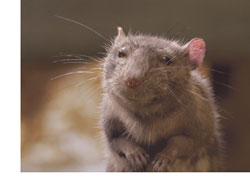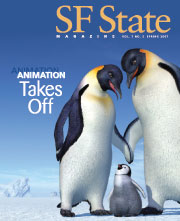 |  | |||
Animated Statements Making a 10-minute silent movie starring only a clay puppet can take a lot of time. For Victoria Livingstone (B.A., '95), the process took more than five years. "I wanted to give myself some sort of lesson," Livingstone recalls of her long-ago student film, "Window." She says she created the piece, which follows a lonesome office worker who dreams of escaping his administrative doldrums, "to convey complex emotion and get an emotional reaction." Hers is the sort of ambition SF State's animation program encourages in its students as they study the craft of creating life from two-dimensional storyboards. Only the most dedicated students stick with animation, due to the amount of time and work required -- as many as 720 drawings to create a single minute of film.
Livingstone, like other alumni of the University's animation program, is prepared for both kinds of success. That versatility is one of the reasons the program has been generating more buzz than a "Shrek" sequel. At SF State, flexibility is built in to the philosophy, which recognizes that sometimes the best team players are individualists. "At the time that I was there, I felt well cared for," Livingstone says, recalling the support she received from faculty, including Patricia Amlin. The animation program "wasn't trying to make a worker out of you. You could be a passionate person, learning to do the job you love to do. You could experiment and find out your interest. That's the whole point of school, isn't it?" (More about creating a singing penguin â¦) The SF State animation program supports students by challenging them to find and trust their own voices. "We strongly encourage auteur filmmaking," says Assistant Professor Martha Gorzycki (M.F.A., '02), who designed the program's curriculum. Workshops spanning a range of animation techniques are open to cinema majors as well as to students of other disciplines who pass a portfolio review. "What ultimately sets SF State's animation program apart," Gorzycki maintains, "is its emphasis on creative individualism -- encouraging students to recognize that the computer is just one small part of the equation." She looks for students with drive, discipline and unique vision. "There is a tendency to believe animators are either artists or craftspeople," she says. "Our program integrates and blurs these boundaries. â¦Highly artistic skills apply to any and all career goals in animation. â¦the students who have produced the most creative and original thesis projects are the first to get hired." Students in Gorzycki's animation classes do not watch the likes of Mickey Mouse, Bugs Bunny or Bambi. Instead, they watch lesser-known experimental, independent animation from around the world. Gorzycki hopes these films will show students the limitless visual boundaries of animation and inspire their own filmmaking. "Animation can be born from everything: architecture, cartography, sand, glass, whatever," she says. (More about Professor Gorzycki's workâ¦) Senior Dave Newlands is among the students who welcome encouragement to look beyond Hollywood's typical commercial imperatives. He finds it reassuring that for artists inclined to "ask questions that might change the way the world thinks, but won't sell tickets, there is someone like Martha there to push them forward, to tell them that that's what the industry needs -- and she always has evidence to back that attitude up." Senior Yi-Chia Mu adds, "She pushes us to think and to express our own ideas. I really feel that if I did not come to the SF State animation program, I would never know that animation can be such a powerful form of filmmaking and art." As much as these artists enjoy making such discoveries, their teachers enjoy supporting their creative endeavors. "The field of animation covers a lot of ground other than just cute funny things," Karl Cohen says. He is a historian of the form, who has taught at SF State since the early '90s, and is president of ASIFA-SF, the San Francisco branch of the International Animated Film Association. "People have ghettoized animation to Saturday-morning type of fare. But there's a lot ⦠that's quite serious," he adds, whether it's the animated film on President Roosevelt's re-election campaign or "Brotherhood of Man," a groundbreaking film that promoted racial equality in 1946.
These days he is hard at work on another Pixar project, still a couple of years from completion -- and as protocol requires, top secret for the time being. What he can't keep under wraps, however, is his excitement about his career. "When you're a kid, you see animation, there's just this pure joy, this pure magic in it. I've grown up with that. My whole life I've thought, âThat's the greatest thing in the world. How can I reclaim that or be part of making it for someone else?'"
Making connections in the industry is key -- and at SF State, students receive access to industry-veteran mentorship before they even graduate. Newlands points out that "Martha and Karl are always out making connections on our behalf and trying to get our work out there, in festivals, or through internships or odd animation jobs, as well as bringing in other artists and filmmakers for workshops and Q&A sessions." The willingness to seek mentoring at every stage of their careers is another trait that sets successful animators apart. Eric Hedman (B.A., '91) worked as an assistant animator on "Meet the Robinsons," a feature film that hit theatres in March. "Mostly I was batting cleanup, paying dues and finishing off the hair, clothes and occasionally prop animation," he says. "I got to work with some amazingly skilled, talented and happening people." Hedman, also a lead artist on Electronic Arts' award-winning "Sims" games, now keeps busy with a host of his own independent projects. Watching graduates find their niche in the field is rewarding for faculty. Cohen keeps in frequent contact with several of his former students, including ASIFA-SF Vice President Laura Tulloss (B.A., '05), who works on Disney TV's "Higglytown Heroes" at San Francisco's Wild Brain animation studio; Dave Thomas (B.A., '95), who lives in Pasadena and is directing a new show for Nickelodeon -- "El Tigre: The Adventures of Manny Rivera"; and Atlanta-based alumnus Jamie Galatas (B.A., '04), who works for Radical Axis, the studio behind "Aqua Teen Hunger Force." Those ongoing industry relationships help keep the SF State program current and on its toes. "Film is changing and will change," Cohen says. "I find it exciting but I find it scary at the same time. I think we're going to find divisions of filmmaking that we really don't even have words for now." SF State animation-program alumni will likely be prepared. "I was surprised a few years back when Disney announced 2D animation was dead and 3D was now the modern form of animation," Gorzycki says. "For me, it is not the technique which makes an animated film compelling to watch, rather it is the strong story and ideas that need to exist first before the technique can be effective in bringing a tale to life." Staying competitive involves more than the expensive proposition of keeping the production lab and computer equipment state-of-the-art. Gorzycki says it's also about investment in the creative capital of the students themselves. "To some degree, technology has helped to expand the visual expressions and hybrid possibilities in art and animation," she adds. "However, I also believe animation itself has an inherent characteristic, which is to foster innovative uses and push artists as far as they will allow their imaginations to go." For Victoria Livingstone, whether she's creating singing penguins or space aliens, she says each project begins with the same universal allure: reaching beyond the limitations of the physical world, out into the realms of imagination. "The challenge is what do we do next? What do we transcend to? I think a good story will always be the best part. If it doesn't have a good story, there's no sense in watching it." -- Jonathan Kiefer is a freelance writer | ||||









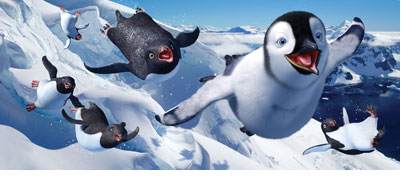 In a movie medium where each moment of motion may require hours to render, tenacity is essential. Livingstone would know. She graduated from the animation program long before finishing her student film. Degree in hand, she found herself busy with her early career, by interning at Pixar (a fairly common practice for SF State animation students.) She later spent more than ten years on staff at Industrial Light & Magic, where her projects included the "Star Wars" prequels. Most recently, she was a lead animator on "Happy Feet," charged with giving life to Gloria, a singing sensation who happens to be a penguin. The film won this year's Oscar for Best Animated Feature, but Livingstone maintains she is equally proud of "Window." The latter film won a Golden Spire at the San Francisco International Film Festival in 2000. "That was really satisfying," she says. "With the studio work, you're working as part of a large team, and it's not really a reflection of you. When [a project] is your own and it has that resonance, it reminds you that you do have your own special voice."
In a movie medium where each moment of motion may require hours to render, tenacity is essential. Livingstone would know. She graduated from the animation program long before finishing her student film. Degree in hand, she found herself busy with her early career, by interning at Pixar (a fairly common practice for SF State animation students.) She later spent more than ten years on staff at Industrial Light & Magic, where her projects included the "Star Wars" prequels. Most recently, she was a lead animator on "Happy Feet," charged with giving life to Gloria, a singing sensation who happens to be a penguin. The film won this year's Oscar for Best Animated Feature, but Livingstone maintains she is equally proud of "Window." The latter film won a Golden Spire at the San Francisco International Film Festival in 2000. "That was really satisfying," she says. "With the studio work, you're working as part of a large team, and it's not really a reflection of you. When [a project] is your own and it has that resonance, it reminds you that you do have your own special voice."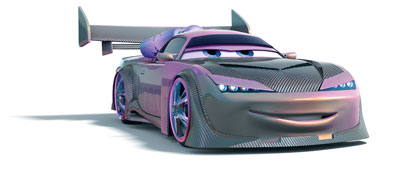 Knowing animation history proved especially useful for Jonas Rivera (B.A., '95), most recently a production manager -- the decider and planner of just what needs doing and when -- for Pixar's "Cars," one of this year's Academy Award nominees. "At school, I immersed myself in the history," Rivera says, citing Gregg Rickman's Disney survey class as a particular favorite. "I became useful to the studio because I knew so much of this stuff. I was able to apply it right away." He started as an intern on "Toy Story," and credits SF State with his active role in Pixar's animation advancements. When production personnel sought historical examples for clues to modern technical challenges -- Didn't a Disney picture do something like this once? -- Rivera says he knew where to find them. (
Knowing animation history proved especially useful for Jonas Rivera (B.A., '95), most recently a production manager -- the decider and planner of just what needs doing and when -- for Pixar's "Cars," one of this year's Academy Award nominees. "At school, I immersed myself in the history," Rivera says, citing Gregg Rickman's Disney survey class as a particular favorite. "I became useful to the studio because I knew so much of this stuff. I was able to apply it right away." He started as an intern on "Toy Story," and credits SF State with his active role in Pixar's animation advancements. When production personnel sought historical examples for clues to modern technical challenges -- Didn't a Disney picture do something like this once? -- Rivera says he knew where to find them. (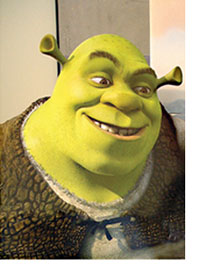 That desire draws many students to the program, but what leads to success in the field? David Spivack (B.A., '93), a DreamWorks Animation artist who just put the finishing touches on "Shrek the Third," encourages aspiring animators to "figure out what you really want to do. Then put 110-percent effort into it. Study outside of school. Take the trouble to learn from the masters." (
That desire draws many students to the program, but what leads to success in the field? David Spivack (B.A., '93), a DreamWorks Animation artist who just put the finishing touches on "Shrek the Third," encourages aspiring animators to "figure out what you really want to do. Then put 110-percent effort into it. Study outside of school. Take the trouble to learn from the masters." (